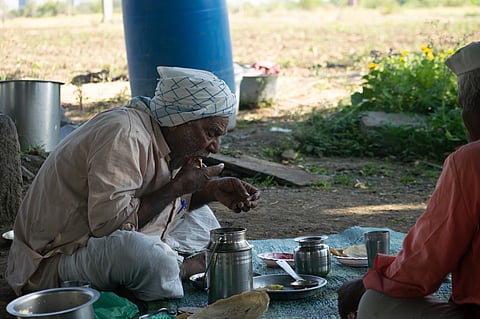

Currently, fewer than 1 per cent of the world’s population is in a ‘safe and just space’, where people’s rights and food needs are met within planetary boundaries. To feed 10 billion people within safe planetary boundaries by 2050, there needs to be a global shift towards “healthier” diets, according to a new report.
The EAT-Lancet Commission report released on October 3, 2025, found that a global shift towards “healthier” diets could cut non-CO2 greenhouse gas emissions, such as methane, from agriculture by 15 per cent by 2050.
The planetary boundaries framework defines nine key Earth system processes that regulate life on Earth. The world has already passed six of these nine boundaries: climate, biodiversity, land, freshwater, nitrogen and phosphorus pollution, and novel entities (pesticides, antimicrobials, and microplastics).
The boundaries essentially mean a “safe operating space” which, if transgressed, would push humanity into an uncertainty zone of rising risks. Food systems are the largest contributor to five of these transgressions and contribute around 30 per cent of greenhouse gas emissions globally, said the report, warning that even with a complete global transition away from fossil fuels, food systems could still push temperatures beyond 1.5°C.
The report by the Commission that comprises leading international experts in climate, nutrition, health, agriculture, social sciences, and economics from more than 35 countries across six continents, talked in detail about a ‘planetary healthy diet’, consisting of plant-rich and minimally processed foods.
The healthy diet concept was first introduced in the 2019 report from the EAT-Lancet Commission and the current findings build on the same report.
Across all regions, the analysis revealed a common shortfall: diets consistently lack sufficient fruits, vegetables, nuts, legumes, and whole grains. However, in many places, it was found that diets contain excess meat, dairy, animal fats, sugar, and excessively processed foods. The report emphasised a plant-rich diet, with optional, moderate amounts of animal-source foods and limited added sugars, saturated fats, and salt.
As part of the Commission’s work, 13 independent modelling groups assessed the potential impacts of food systems change on five of the planetary boundaries: climate, land, freshwater, nutrients pollution, and novel entities (pesticides, antimicrobials, and microplastics).
This work outlined the potential of food systems transformations that include the adoption of healthy diets, reduced food loss and waste, and improved production practices to advance human health and reduce pressure on the environment. The analysis integrates diverse datasets, including diet and health outcomes, into a unified framework that maps a safe and just operating space for food systems globally.
Drawing on this modelling, the report set the boundaries of how 9.6 billion people globally can eat nutritiously and equitably within critical environmental boundaries by 2050. This can happen by changing the way the world produces and consume food, which can improve global health, achieve food and nutrition security, build stability and resilience, and contribute to critical strategies to improve equity and working conditions in food systems.
The analysis showed that reshaping systems could deliver returns of US$ 5 trillion a year through better health, restored ecosystems, and climate resilience — more than 10 times the US$200-500 billion investment needed to drive food systems change.
Further, shifting global diets could prevent approximately 15 million premature deaths per year, the report found.
The Commission outlined eight potential solutions aimed at advancing health, environmental, and justice goals:
· Protect and promote traditional healthy diets
· Create accessible and affordable food environments that increase demand for healthy diets
· Implement sustainable production practices that store carbon, create habitat, and improve water quality and availability
· Halt agricultural conversion of intact ecosystems
· Reduce food loss and waste
· Secure decent working conditions across the food system
· Ensure meaningful voice and representation for food systems workers
· Recognise and protect marginalised groups
“The report sets out the clearest guidance yet for feeding a growing population without breaching the safe operating space on Earth set by the planetary boundaries. It also exposes the stark winners and losers in today’s food systems, where entrenched power dynamics drive deep inequities. By uniting the latest science on health and climate, it shows that what we put on our plates can save millions of lives, cut billions of tonnes of emissions, halt the loss of biodiversity, and create a fairer food system,” said study co-author Johan Rockström, who leads the Potsdam Institute for Climate Impact Research.
According to the report, currently almost a third (32 per cent) of food systems workers earn below a living wage. Meanwhile, the wealthiest 30 per cent of people drive more than 70 per cent of food-related environmental impacts, and despite global calorie sufficiency, more than one billion people remain undernourished.
“Food is at the heart of both human well-being and planetary health. Right now, too many people who grow and process our food are underpaid and excluded from basic protections, while the environmental and health costs fall hardest on the most vulnerable. Our findings make it clear that transformation must go beyond producing enough calories. It must guarantee the right to food, fair work, and a healthy environment for all,” Shakuntala Haraksingh Thilsted, Commission Co-Chair and Director for Nutrition, Health and Food Security at CGIAR, said.